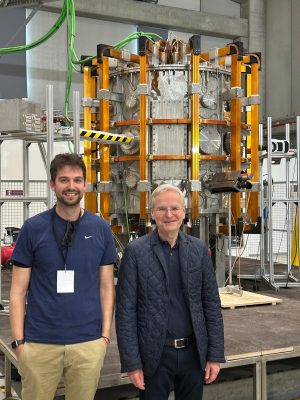
The 18th Technical Meeting on Energetic Particles in Magnetic Confinement Systems took place from 17th to 21st March in Sevilla, Spain. This conference tackles the state-of-the-art of physics on energetic particles in magnetically confined plasmas, delving into relevant aspects for fusion plasmas such as triggering and controlling instabilities, studying Alfvén modes, runaway electrons and fusion born alphas. Our group member Dani Gallart was invited to deliver a talk on a novel method for the detection of alpha heating.
The conference was well packed during the 5 days with interesting and cutting-edge studies at the forefront of the present understanding. Our work, entitled “Novel method for the detection of alpha heating in JET-ILW DT plasmas”, described the method developed at the Joint European Torus (JET, UK) by an international team of researchers (the M21-17 team) on how to detect alpha heating in fusion devices with a gain factor Q < 1.
For such machines, there are other heating mechanisms, such as slowing down of neutral beams and RF resonant ions, which are greater than alpha heating and, thus, might screen its effects. The method is based on leveraging the fact that fusion born alpha particles (3.5 MeV) have long slowing-down times and most of their energy is channeled to electrons. Therefore, it is expected to observe a delay on the electron temperature as compared to the ion temperature; this is indeed what was observed at JET during the second Deuterium-Tritium campaign (DTE2). A Fourier analysis of the heating signals shows that the only mechanism to produce such delay is alpha heating. This method could be used in several other machines, especially those with Q < 1, or during operational phases where maximizing fusion power is not the goal but assessment of alpha heating/confinement needs to be studied. A comprehensive description can be found in this paper published in Nuclear Fusion.

The conference was hosted by the University of Sevilla, who made an excellent organization of the event. A trip to the SMART tokamak, which is being built by the group of Sevilla, was an inspiring and interesting visit where we had the chance to see how they are assembling this promising machine.
Personally, I was very happy to meet with old friends and researchers with whom I have shared not only discussions but also few drinks and dinners in the past and had not seen for a long time after the COVID struck back in 2020. Moreover, I was delighted to meet with Lars-Göran Eriksson with whom I discussed precisely the modelling work I presented at this conference.
All in all, it was a great experience in the beautiful city of Sevilla.
